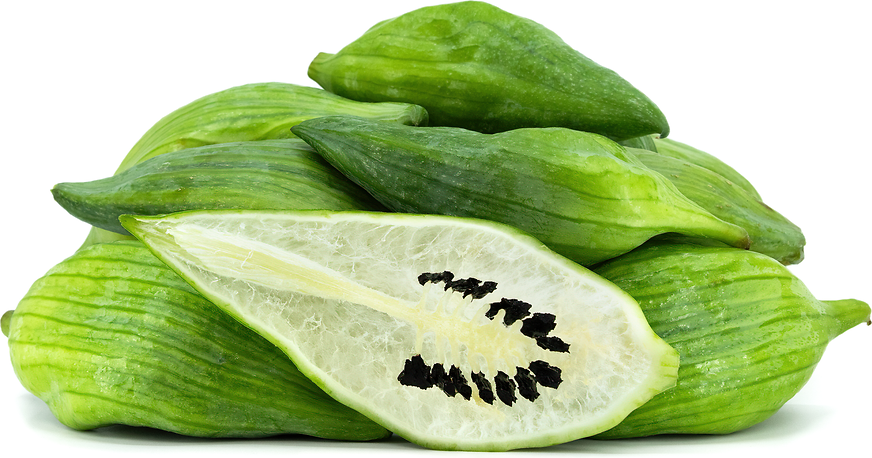


Caigua
Estimated Inventory, lb : 0
Description/Taste
Caigua is a small, ovoid to tear-drop shaped fruit, averaging 10 to 15 centimeters in length, that tapers to a rounded point on the non-stem end. The pods are dark green with smooth, ridged skin when young, ripening to a light yellow-green hue with smooth or spiked skin, depending on the variety. Underneath the surface, the flesh is pale green to white with a spongy and crisp consistency. Over time, the flesh will begin to hollow, developing a cotton-like texture, encasing several black seeds in the center of the pod. The seeds are edible and soft when young, transforming into hard, black, and inedible, arrow-shaped kernels. Raw Caigua is crunchy and has a flavor similar to cucumbers and sweet peppers. When cooked, the fruit softens, developing a flavor reminiscent of green peppers.
Seasons/Availability
Caigua is available year-round, with a peak season in the fall.
Current Facts
Caigua, botanically classified as Cyclanthera pedata, is a rare South American fruit that belongs to the Cucurbitaceae family. Also known as Achocha, Caihua, Wild cucumber, and Stuffing cucumber, Caigua is cultivated throughout the Andes region of South America as a food source and medicinal ingredient, used by civilizations for thousands of years. In the modern-day, Caigua is grown on a smaller scale and is prevalent in local markets but challenging to find in larger supermarkets due to the lack of commercial cultivation. Caigua is highly favored in Peru for its mild, vegetal flavor, and both the young and mature fruits can be harvested for consumption, utilized in preparations similar to bell pepper.
Nutritional Value
Caigua is an excellent source of vitamin C, which is an antioxidant that can help boost the immune system and is a good source of fiber, which can help regulate the digestive tract. The fruit also contains some potassium, magnesium, calcium, zinc, phosphorus, and iron. The Incas used Caigua as a medicinal ingredient, primarily made into a tea as a remedy for high cholesterol, diabetes, or gastrointestinal problems. It was also used as an anti-inflammatory, diuretic, and analgesic, and the fruits were boiled in milk and gargled to remove inflammation associated with tonsillitis.
Applications
Caigua is best suited for both raw and cooked applications such as sautéing, frying, baking, stewing, and boiling. When raw, Caigua can be eaten fresh, out-of-hand, much like a cucumber, or it can be chopped and tossed into salads, sliced and served with dips, or blended and juiced into a mild beverage. It can also be breaded and fried, used as a substitute for green peppers in recipes, sautéed as a side dish, or pickled for extended use. In Peru, Caigua is commonly cooked into a stew-like, sofrito dish and mixed with mashed potatoes. In addition to the fruits, the leaves and young shoots are edible and can also be lightly sautéed or incorporated into salads for added nutrient benefits. Caigua pairs well with meats such as beef, pork, poultry, and fish, eggs, red onion, parsley, cumin, potatoes, peppers, tomatoes, peanuts, raisins, and black olives. The fresh fruits will keep 1 to 2 weeks when stored whole and unwashed in the crisper drawer of the refrigerator.
Ethnic/Cultural Info
In the district of San Miguel, located within the Lima region of Peru, Caigua is a traditional ingredient showcased at the Pacha Gastronomic Festival. The annual two-day event was established to pay homage to the traditional cuisine of Peru while showcasing the future of gastronomy within the diverse country. During the festival, there are many different chefs, vendors, and food trucks that prepare modern and classic dishes, including Caigua rellena, which is Caigua stuffed with meats, grains, and vegetables and coated in a chile sauce. Stuffed Caigua is one of the most common preparations of the fruit and is considered to be a recipe that honors the past while promoting the future, depending on the ingredients used in the stuffing. The festival also promotes live cooking demonstrations from young, up-and-coming chefs to showcase their talents and encourage networking.
Geography/History
Caigua is native to the coastal Andes region of Peru in South America, where the vine has been cultivated since ancient times. The fruit was first documented through illustrations on pottery that was recovered from the Moche civilization, dating to 800 CE. It was also believed that the Incas cultivated the fruits for food and medicine, and many of the culinary preparations that are used for Caigua today stem from the original Incan recipes. Today Caigua can be found through local markets in South America, especially in Peru, Bolivia, Ecuador, and Columbia, and has also spread into Central America, the Caribbean, the United States, and Mexico. Caigua can also be found in limited quantities in Europe, Asia, and Southeast Asia, cultivated on a small scale through specialty farms and in home gardens.
Recipe Ideas
Recipes that include Caigua. One
| The Kitchen at the Top of the World |
|
Tex-Mex Stuffed Caigua |
| Bolivia Bella |
|
Achojcha Rellena - Bolivian Stuffed Caigua |
| Bala Beach |
|
Stuffed Cucumber aka Caigua or "Pepino Para Rellenar" |

















